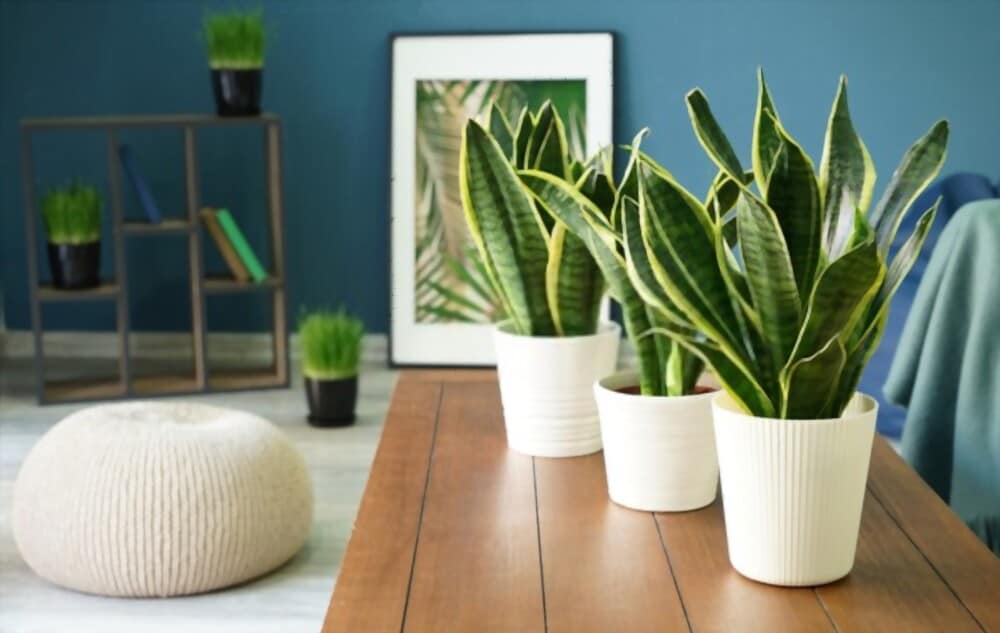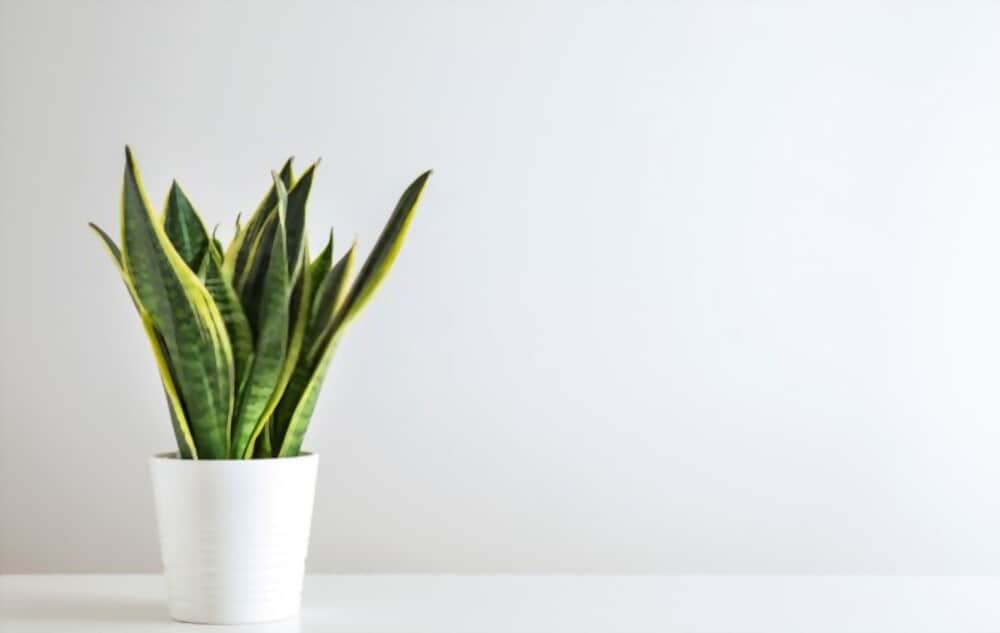The environment that snake plants are exposed to has a significant impact on them. They don’t need much attention, but you should make sure they get the right amount of lighting to keep their leaves from getting too thin.
If they don’t receive enough sunshine, snake plant leaves have a tendency to become narrow. The leaves will incline to bend and grow toward the light in low light situations. They grow narrow and elongated as a result. Fixing the issue involves rotating the plant and adding more light.
Snake plants (Dracaena trifasciata) can suffer from a variety of problems, such as low light levels, transplant shock, frequent watering, overwatering, and underwatering.
We’ve covered in depth in this article how both low and bright sunlight can impede the healthy development of your snake plants and what you can do to solve it.
Table of Contents
What Causes Snake Plant Leaves To Become Narrow and Skinny?
You would probably notice your snake plant growing longer, thinner leaves if you had placed it in a location with no light or very little light.
When cultivating a snake plant for the first time, people frequently manage to get the light and water requirements wrong, in particular.
The growth and health of a snake plant can be significantly impacted by both low and high sunshine intensity.
Most people think of snake plants as tropical attractive foliage plants that can thrive in low light conditions. Snake plants, on the other hand, are succulents and require moderate to bright indirect sunlight to flourish.
NOTE: Prior to 2015, botanical researchers thought the snake plant belonged to the Sansevieria genus (low light houseplant). However, they discovered in 2015 that the snake plant is actually a species of Dracaena (sun-loving succulent).
Many business establishments continue to utilize them as low-light houseplants, nevertheless. As a result, people continue to misplace their snake plants, which harms the plants, in low-light or dark areas.
When I know my plants aren’t getting the amount of light they need, I use an 80W Full Spectrum Plant Light from Amazon, which is affordable and energy-efficient.
How does Lack of Light Cause Snake Plant’s Leaves To Become Narrow or Skinny?
A plant’s ability to grow properly depends on sunlight. It’s interesting to note that plants have a large number of photosensory receptors to identify sunlight.
As a result, plants modify their growth pattern and development plans in response to the presence of sunshine. All plants can be categorized into either shade-avoiding or shade-tolerant varieties based on how they respond to leaf shading.
The shade-tolerant category includes snake plants. The snake plant’s capacity to thrive in low-light conditions is one of its distinctive traits. It can live in dimly lit environments.
Your snake plant will begin to produce longer, narrower leaves in an effort to obtain sunlight when it does not receive enough light for photosynthesis.
If not put in brilliant indirect sunlight, your snake plants will likely try to extend and bend toward the source of sunshine. See our article on the causes of sideways plant growth.
It does not necessarily follow that they will thrive aggressively even though they can survive in low sunshine.
Your snake plant will only develop healthily if you provide it the right conditions and sunlight. Otherwise, it’s just putting up with things and trying to survive.
For more information on how plants may thrive without light, visit this article.
How To Correct The Problem?
Sunlight is essential for snake plants to make food (photosynthesis), just like it is for all other plants. Unlike popular belief, snake plants like more sunlight.
Your snake plant will begin to produce thicker, straighter leaves if you move it to a more sunny area or room. In the late fall, remove all of your snake plant’s thin, narrow leaves. Hopefully, fresh new leaves will quickly sprout.
Ensure that your snake plant receives at least four to five hours every day of bright indirect sunlight by placing it in a south-facing window.
Keep rotating your snake plant on a regular basis to ensure that all of the leaves receive an equal amount of sunlight. This will avoid leaves from bending or leaning toward the source of sunlight.
Rotating the Plant
In order to receive as much light as possible for photosynthesis, a plant’s method of generating energy, phototropism is a natural process where a plant develops in the direction of the light source.
Auxin molecules accumulate on the side of a plant that receives less light, lengthening the cells there and forcing the plant to bend toward the light, giving the appearance of being twisted and narrow.
See our comprehensive post on rotating indoor plants to make sure they thrive in low light.
You might want to look into this Rotating Swivel from Amazon if you want to make the rotation procedure simple because it is affordable and eases the strain on your back when rotating plants.
How Light Affects Plant Growth?
Indoor plants, whether they are in homes or nurseries, need the ideal environment for healthy growth and development.
Light is one of the most important environmental factors that can have a significant impact on the growth of indoor houseplants. Numerous studies have demonstrated how light may dramatically affect a plant’s size, shape, flower bud development, and flower abortion.
Not all houseplants prefer dim lighting. For healthy growth, many indoor houseplants need a variety of light intensities. It is well known that snake plants prefer medium to bright indirect light. But why do we use indirect sunlight?
Both direct and indirect sunlight have a significant impact on how plants develop via light (photomorphogenesis) and how resources are distributed among their structural components.
Plant length, flowering, and lateral branching can all be influenced by light. We have covered in great depth how light might influence the growth of snake plants down below.
Direct Sunlight:
While moderate to strong light is what snake plants prefer most, intense sunshine can actually damage their leaves.
Therefore, it is much safer to place your snake plant somewhere that it won’t be immediately exposed to sunlight.
Some snake plant species can withstand direct sunshine better than others. But they don’t enjoy the sun. Additionally, if you place most snake plant species in direct sunlight, they will burn.
Anytime you place your snake plant in direct sunlight behind a window, it may become wrinkled. A snake plant can be severely burned by direct sunlight.
Your snake plant will grow more successfully in some shade as opposed to direct midday sunlight.
Indirect Sunlight:
Indirect sunlight is what you see through the glass doors or windows. There are two categories of this indirect light: bright indirect light and medium indirect light.
Indirect sunlight influences not just the size of the plant but also how much food is distributed to different regions.
Indirect light that is moderate to bright is ideal for growing snake plants. Snake plants don’t like the direct midday sun, as we already said in the article.
Indirect sunlight is the ideal for snake plants.
Low or medium light conditions might have a negative impact on the growth and reproduction of snake plants. For the purpose of capturing light, leaves and stems are supplied energy that should be used for reproduction.
Snake plants have unique cells in their leaves that absorb the light they require. These unique cells congregate when a snake plant is placed in a low-light environment to absorb the most sunlight that is available.
Snake plants shift the position of their leaves such that these cells face the light. akin to how window shades would be open wide.
However, these unique cells are positioned differently when exposed to direct sunlight in order to avoid confronting it.
How To Prepare Snake Plants To Face Sunlight Full Time?
Make careful to allow your snake plant enough time to reposition its light-gathering cells before putting it in the midday sun.
If not, a brief exposure could severely burn your docile snake plant.
Before repositioning your snake plant to face the midday sun, it is preferable to give it at least two weeks to alter its light-gathering cells in leaves.
Put your snake plant outside in the shade for the first three to four days. Allow it to adjust there. After three days, relocate it to a location where it can receive a minimum of four to five days of morning light exposure.
Hopefully, your snake plant will be able to face the light without getting burned or injured in two weeks.
Other Problems Snake Plants are Affected With:
Snake plants can also struggle from leaves that are drooping or falling, in addition to having slim, narrow leaves.
Drooping:
Snake plant leaves can begin to droop. Your snake plant may begin to drop leaves for a number of causes, including as overwatering, inadequate drainage, a lack of sunlight, or pests.
The most likely causes of all of your leaves drooping are overwatering and poor water drainage.
Only one or two drooping leaves, however, indicate a problem with sunlight.
Some of the leaves of your snake plant may begin to droop if it is lacking in sunlight and unable to carry out its typical photosynthesis process.
How Drooping Can be Fixed?
Change the soil to improve drainage if your snake plant is being overwatered and has poor drainage, and only water it when you notice that the dirt in the container is fully dry. Snake plants don’t really need to be watered every day.
If the plant is kept in a dimly lit area, you only need to lightly water it once a week. When the potting soil is entirely dry and there is direct sunlight, water the plant.
With Miracle-Gro Indoor Potting mix, repotting will be a success. All of my indoor plants receive this treatment, which guarantees their survival even after repotting.
The Species of Snake Plant –
It’s possible that the snake plant species you own has thin leaves. The Sansevieria trifasciata, Craigii and Sansevieria trifasciata, Nelsoni species of snake plants are distinguished from the more common Sansevieria Varieties by their narrow leaves.
FAQ
How do I get my snake plant to grow new leaves?
Water should be added to the cut end of the leaf to cover the tissue at the bottom. Put the container in an area with indirect lighting, and replace the water every few days. Little roots will soon be visible. Put the rooted leaf in sand or peat moss and take the normal maintenance of a snake plant.
How do you encourage new growth on a snake plant?
Choose the perfect container for your snake plant, give it the right quantity of water, lots of sunlight, fertilize frequently, and keep an eye out for pest infestations to encourage rapid growth. Green leaves will grow on your snake plant if it receives enough bright light and a tiny amount of fertilizer.
Why is my snake plant not getting bigger?
A snake plant cannot grow because of the frigid temperatures, low light levels, and shorter day lengths that have caused it to enter a dormant state. If the room temperature is above 16 degrees and there are enough hours of brilliant indirect sunlight, snake plants will only grow visibly.
Why is my snake plant growing so thin?
If they don’t receive enough sunshine, snake plant leaves have a tendency to become narrow. The leaves will incline to bend and grow toward the light in low light situations. They grow narrow and elongated as a result. Fixing the issue involves rotating the plant and adding more light.


